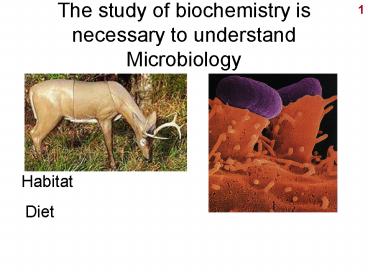The study of biochemistry is necessary to understand Microbiology - PowerPoint PPT Presentation
Title:
The study of biochemistry is necessary to understand Microbiology
Description:
Title: The study of biochemistry is necessary to understand Microbiology Author: Dr.s Gilmore Last modified by: D Gilmore Created Date: 7/6/2005 1:07:31 AM – PowerPoint PPT presentation
Number of Views:54
Avg rating:3.0/5.0
Title: The study of biochemistry is necessary to understand Microbiology
1
The study of biochemistry is necessary to
understand Microbiology
Habitat
Diet
2
Why Chemistry?
Conflict between microbe and host.
Vibrio cholera toxin inserting into intestinal
cells.
3
Terms and Definitions to review and Remember
- Solution
- Atom, protons, neutrons, electrons, isotopes,
elements, molecules, ions, anions, cations,
compounds, covalent bonds, ionic bonds, hydrogen
bonds, pH, acids, and bases.
- Suspension
4
Atom smallest unit of an elementElements differ
by number of protons
http//www.perceptions.couk.com/imgs/atom.gif
5
Molecule atoms joined together with covalent
bonds
Electrons are shared between atoms. Forms strong
bonds. When atoms in the molecule are of
different elements, the substance is called a
compound.
http//www.truenorthgb.com/images/molecule.jpg
6
Covalent bonds polar molecules
Covalent Bonds sharing of electrons between the
oxygen and hydrogen atoms. Strong. Oxygen is an
electron hog the electrons spend more time there
leaving the hydrogens proton nearly naked (and
somewhat positive) Water is a polar molecule
Water
mdp2.phys.ucl.ac.uk/ Talks/Ice/Ice.html
7
Hydrogen bonds
- Electrical attraction between electronegative
oxygen atom and nearly naked proton. - Bonds made between polar molecules.
- Weak bonds.
8
H-bonds hold large molecules together
Example A-T base pair in DNA
http//www.mun.ca/biology/scarr/Fg10_16a.gif
9
Hydrophilic and hydrophobic
Surfaces made of molecules without polar groups
(e.g. CH3CH2CH2CH2.) repel water.
10
H2O ? H OH- K (H OH-)/ H2O 10-7
pH -log H Logarithmic pH 7 is neutral Ranges
from 0-14 Molecules that release H are acids
those that release OH- are bases.
http//www.btinternet.com/chemistry.diagrams/ph_s
cale.gif
11
Functional Groups
12
Chemical Reactions
- Synthesis or decomposition reactions
- More when we cover metabolism.
- Reactants Products (general)
- Substrate(s) Products (enzymatic)
C12H22O11 H2O 2 C6H12O6 Hydrolysis (left to
right) Dehydration (right to left)
H2O
http//www.unisanet.unisa.edu.au/08365/timages/suc
rose.jpg
13
Small molecules (monomers) and macromolecules
(polymers)
Ethylene and polyethylene
14
Four Classes of Biological Molecules
- Carbohydrates
- Sugars and their polymers
- Nucleic acids and nucleotides
- DNA, RNA, ATP
- Lipids
- Various hydrophobic molecules
- Proteins and amino acids
15
Carbohydrates CH2O
Monosaccharides glucose, fructose, many
others Disaccharides sucrose,
lactose Oligosaccharides found on
glycoproteins, in cytoplasm (oligo- means
few) Polysaccharides starch, glycogen, agar,
chitin, xanthan gum
16
(No Transcript)
17
(No Transcript)
18
(No Transcript)
19
A nucleotide a monomer of DNA
http//www.emc.maricopa.edu/faculty/farabee/BIOBK/
nucleotide.gif
20
Nucleic acids are the polymers made from
nucleotides.
DNA tRNA
http//www.biochem.uwo.ca/meds/medna/IMG/tRNA.GIF
21
Structure of DNA
http//academic.brooklyn.cuny.edu/biology/bio4fv/p
age/molecular20biology/16-05-doublehelix.jpg
22
(No Transcript)
23
Phospholipids are essential building blocks for
membranes sterol-type molecules are rarely
found in bacteria.
24
A lipid polymer a biodegradable plastic made
by bacteria.
25
Inclusions of PHB in a bacterial cell
26
(No Transcript)
27
(No Transcript)
28
(No Transcript)
29
(No Transcript)































